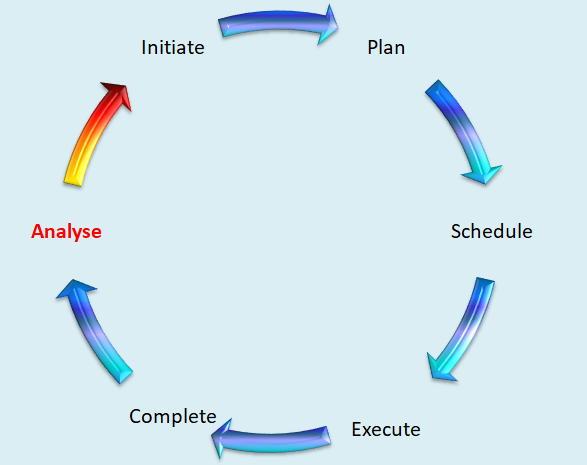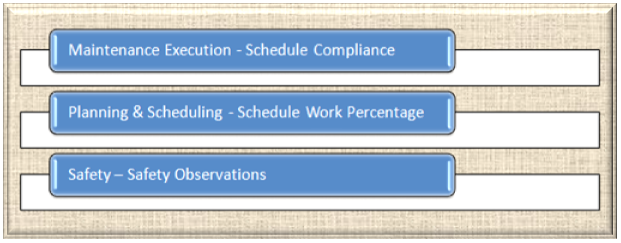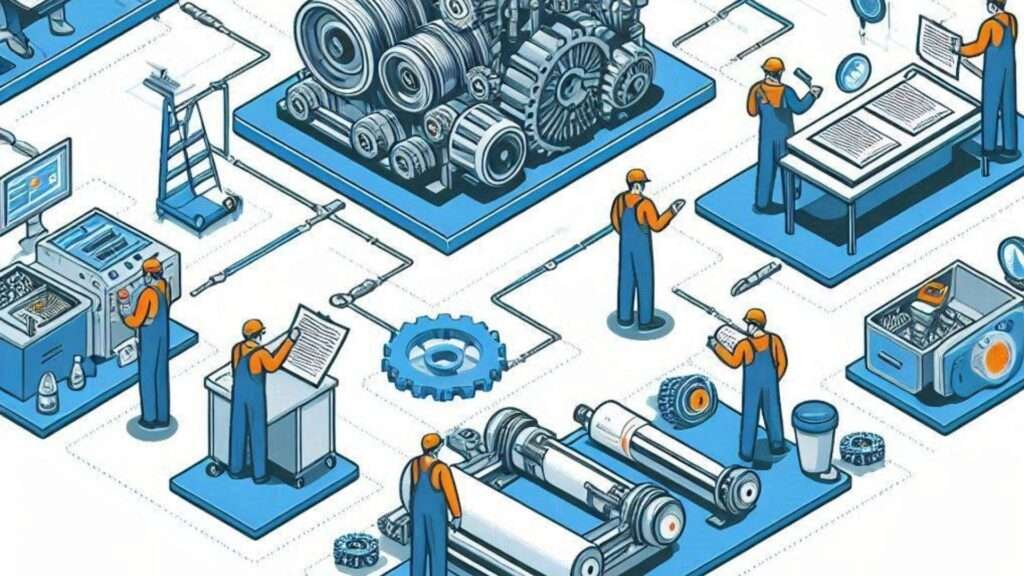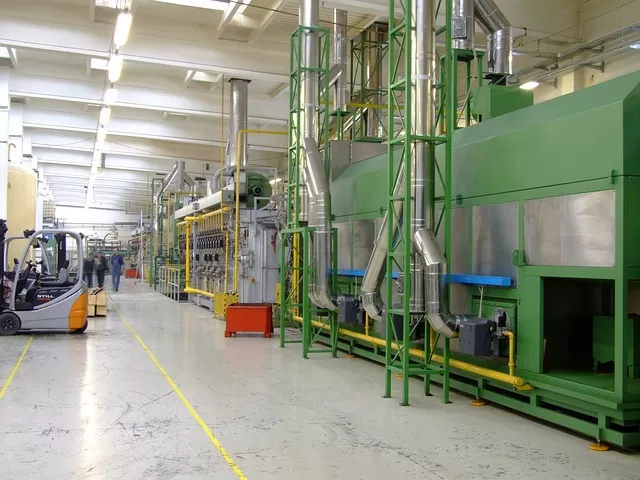Scheduled Work Percentage & Other Maintenance Performance Measures.
Measure
and review your maintenance process’s performance on a regular basis.
Use the metrics
you adopt such as Scheduled Work Percentage to identify areas for improvement
and ensure that results are managed to completion.
Schedule
compliance is a crucial lead metric, indicating the effort put into improving
the organization.
1.
Safety
Observations:
Conducting
regular safety observations fosters an interdependent safety culture. Effective
safety observations involve active listening and mutual concessions, allowing
maintainers to connect with leadership and continuously improve safety
practices.
2.
Leading
and Lagging Indicators:
Use
a combination of leading and lagging indicators to evaluate trends and outcomes.
Leading indicators predict future performance, while lagging indicators reflect
past performance.
Together,
they provide a comprehensive view of your maintenance process.
3.
Scheduled
Work Percentage:
Aim
for a 70% target for Scheduled Work Percentage, which measures the actual hours
recorded on scheduled work orders versus all work orders.
Ensure
all contractor work hours are recorded, even if they don’t have direct access to
the CMMS. Possible solutions include manual entry, developing a contractor
portal, or providing special CMMS access.
4.
Scenario
Analysis:
Analyse scenarios where scheduled work ratios and schedule compliance are low. Low scheduled work ratios may indicate neglect of scheduled work in favour of emergency tasks.
Good scheduled work ratios but low compliance may suggest equipment failures or incomplete work order processing. Investigate these scenarios to improve maintenance strategies and prevent future issues.
5.
Tips
for Good Scheduled Work Percentage Results:
a)
Avoid Overloading:
Don’t
overload your workforce with scheduled work.
Balance
is key to maintaining practical and effective maintenance schedules.
b)
Maintain Realistic Schedules:
Don’t
deliberately reduce scheduled work to improve compliance percentages. Stick to
tasks that are essential to your maintenance strategy.
c)
Conduct Root Cause Analysis:
Use
the ‘5 Whys Analysis’ on emergency work orders to identify underlying issues
and improve future schedules.
d)
Daily Queries:
Set
up daily queries in your CMMS to track work orders with actual hours entered
and their completion status.
This
helps ensure tasks are genuinely completed.
Top 8 Takeaways.
1)
Schedule Compliance: A key lead
metric indicating the effectiveness of maintenance scheduling.
2)
Safety Observations: Regular
observations foster a safety culture and improve communication between
maintainers and leadership.
3)
Leading vs. Lagging Indicators:
Combining both types of indicators helps evaluate trends and outcomes.
4)
Scheduled Work Percentage: A
metric to understand where maintenance hours are spent, aiming for a 70%
target.
5)
Contractor Work Hours: Ensure all
contractor hours are recorded, possibly through a contractor portal or manual
entry.
6)
Workforce Management: Avoid overloading
with scheduled work and ensure emergency tasks are analysed for future
improvements.
7)
5 Whys Analysis: Conduct this
analysis on emergency work orders to improve future schedules and equipment
reliability.
8)
Daily Queries: Set up queries to
track work order completion status and actual hours entered.

Using Leading & Lagging metrics when analysing Maintenance Performance
Your maintenance process’s performance must be measured and reviewed, and any chances for improvement must be pursued. Evidence that measurements are examined at regular meetings and results are managed to completion should be presented.

Leading Metrics
These metrics look at the effort you are putting in to improve your organisation and will indicate that some changes may be visible before they occur.

Schedule Compliance
Schedule compliance is an incredibly effective lead metric.
If your schedule compliance percentage is low, some causes may be:
- Scheduled work is not being completed due to an increase in the amount of emergency or breakdown work orders taking priority and hijacking the maintenance team’s efforts.
- Your company is yet to become proactive in its maintenance approach and is still very much in a reactive state.
- Too much scheduled work is being approved, highlighting inefficiency in scheduling meetings. This could involve a large number of unneeded and excessively frequent preventive maintenance jobs; maintainers should provide feedback to supervisors on these occurrences.
- Your equipment reliability is starting to drop away
- You may have had a high turnover of personnel in recent times, a large number of new employees who are still learning your equipment, and you may have relied extensively on contractors to replace unfilled positions on an as-needed basis.
- It’s also conceivable that you’re not gaining enough knowledge from your breakdown work. Although maintenance teams dislike having to respond to urgent failures at all hours of the day and night, it’s critical that you employ problem-solving skills to fully understand what’s going on and use this information to strengthen your preventative maintenance efforts. Consider using a tool like ‘Why Why Analysis.’
Safety Observations

When safety observations are conducted on a regular basis, it helps to foster an interdependent safety culture and an environment in which people believe they can speak freely and be heard often. They provide an opportunity for maintainers to connect with the leadership team, and the key to excellent safety observations, like with any other sort of human interaction, is mutual concessions/compromise; a little back and forth works great.
Those doing safety observations should keep in mind that they only have two ears and one mouth, therefore they should listen twice as much as they talk. Listen to what others are saying if you want the observation to be a positive experience for everyone involved. Active listening skills will reveal bits and pieces of knowledge that you can utilise to continuously improve safety and you might be surprised at how much you will learn.
LAGGING METRICS
These metrics show the outcomes of what’s been happening in your company and will record your actual performance after the events have happened.

Lagging indicators are always prompted by recent events and as such are a little more self-explanatory than leading indicators.
Lagging indicators work best when combined with leading indicators to evaluate trends and whether or not outcomes were met.
With the right technology and regular review sessions that evaluate leading and lagging signs, continuous improvement is possible.
Understanding SChedule work
70% is a
worthwhile initial target for Schedule Work Percentage.
The goal
of the ‘Scheduled Work Percentage’ metric is to fully understand where all your
maintenance departments work hours are actually being executed as apposed to
where you wanted them to be executed.
For this metric to be effective, you need to make sure all contractor
work hours are being entered on work orders.
It’s possible that a lot of your contractors won’t have CMMS access, so
you will have to develop a workaround solution to make sure these hours are
recorded.
Examples
of a workaround solution are:
·
Your staff will need to Manually
enter contractor actual hours against work orders
·
Develop a ‘Contractor Portal’
where their parent company can enter the required information into a software
product that is interfaced with your CMMS and populates the actual hour’s data.
·
Give all contractors a ‘special’
level of access to your CMMS
Tip:
I
recommend that you allow contractors to be able to enter comments against hour
entry data, for instance, if a job has required 50% more hours than planned/scheduled,
then a comment from the actual contractor that did the work would be of very
high value.
How is the Schedule Work Percentage calculated?
Schedule
Work Percentage = Actual Hours Recorded on Work Orders coded as ‘Scheduled’ divided
by the Actual Hours Recorded on all Work Orders.
Review Scenario 1: Your Scheduled Work Ratio was low for the last period and your schedule compliance was low.
This may
indicate that scheduled work is being neglected and emergency and other high
priority unplanned work is being done instead.
Review Scenario 2: Your Scheduled Work Ratio was good but you notice that your schedule compliance is low
This
tends to indicate that you’ve been able to execute the work on the schedule but
you have experience a large amount of equipment/component failures. This scenario should prompt investigation
by your reliability team. You may be on
the verge of experiencing more equipment reliability issues. This should prompt reviews of the
maintenance strategies associated with the equipment that failed during this
period, it’s possible that you’re not doing enough of the right type of
proactive tasks.
There is
also a chance that this scenario is a result of people partially processing
completed work, they’ve entered their actual hours against the work order
numbers but have not updated the status of the work order to ‘Complete’.
Here are a few tips relating to ‘Scheduled Work
Percentage’
1.
Don’t overload your workforce
with Scheduled Work; while doing nothing but ‘Scheduled Work’ could be
described as a ‘Maintenance Utopia,’ there are probably only a few scenarios on
this planet where that may be practical.
2.
Don’t deliberately load a smaller
than normal/expected percentage of scheduled work into the forthcoming
execution period just because you want to make your next schedule compliance
percentage looks a bit better. A big
chunk of your scheduled work is going to be tasks that are approved outputs of
your maintenance strategy, not doing these tasks will put at risk of unplanned
failures.
3.
Be sure to conduct ‘5 Whys
Analysis’ on as many of the emergency/breakdown work orders that occurred
during the execution period as possible.
What you learn from this analysis will help you produce more effective
schedules in the future and increase your equipment reliability.
4.
Set up a daily query within your
CMMS to show what work orders have had actual hours entered against them and
what the relating completion status is.
The Maintenance Supervisor should be able to indicate if those tasks are
actually complete or not.








